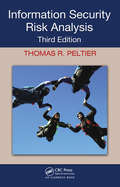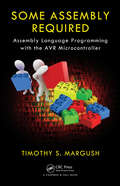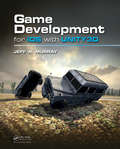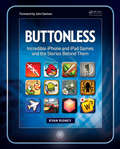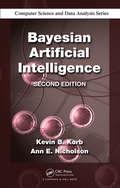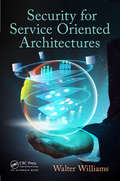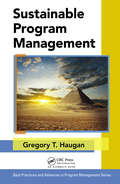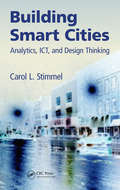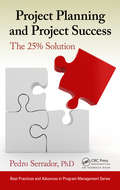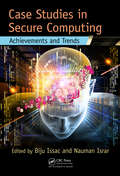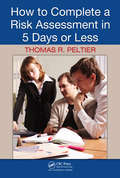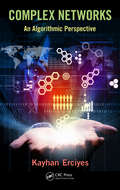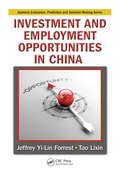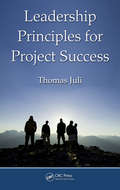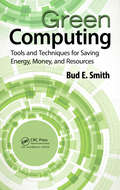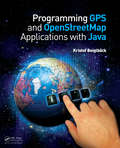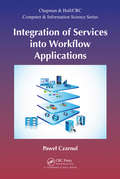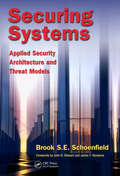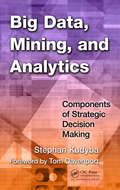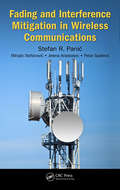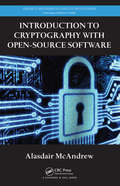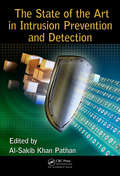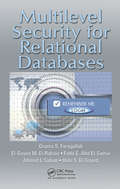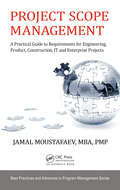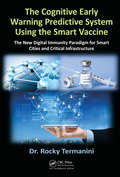- Table View
- List View
Information Security Risk Analysis
by Thomas R. PeltierSuccessful security professionals have had to modify the process of responding to new threats in the high-profile, ultra-connected business environment. But just because a threat exists does not mean that your organization is at risk. This is what risk assessment is all about. Information Security Risk Analysis, Third Edition demonstrates how to id
Some Assembly Required: Assembly Language Programming with the AVR Microcontroller
by Timothy S MargushA family of internationally popular microcontrollers, the Atmel AVR microcontroller series is a low-cost hardware development platform suitable for an educational environment. Until now, no text focused on the assembly language programming of these microcontrollers. Through detailed coverage of assembly language programming principles and technique
Game Development for iOS with Unity3D
by Jeff W. MurrayThis hands-on guide takes you through the complete process of Unity iOS game development. A game developer for over 12 years, the author presents production-proven techniques and valuable tips and tricks needed to plan, build, test, and launch games for the iPhone, iPod, and iPad. He walks you through all the necessary procedures, including how to publish your game to the App Store.
Buttonless: Incredible iPhone and iPad Games and the Stories Behind Them
by Ryan RigneyThis book presents some of the most interesting iPhone and iPad games, along with stories of the people behind these games. It describes hundreds of titles, including well-known games and hidden games, and provides insight into the development of games for the iOS platform.
Bayesian Artificial Intelligence (Chapman & Hall/CRC Computer Science & Data Analysis)
by Kevin B. Korb Ann E. NicholsonThe second edition of this bestseller provides a practical and accessible introduction to the main concepts, foundation, and applications of Bayesian networks. This edition contains a new chapter on Bayesian network classifiers and a new section on object-oriented Bayesian networks, along with new applications and case studies. It includes a new section that addresses foundational problems with causal discovery and Markov blanket discovery and a new section that covers methods of evaluating causal discovery programs. The book also offers more coverage on the uses of causal interventions to understand and reason with causal Bayesian networks. Supplemental materials are available on the book's website.
Security for Service Oriented Architectures
by Walter WilliamsThis book examines both application and security architectures and illustrates the relationship between the two. Supplying authoritative guidance through the design of distributed and resilient applications, it provides an overview of the various standards that service oriented and distributed applications leverage to provide the understanding required to make intelligent decisions regarding their design. The book reviews recent research on access control for simple and conversation-based web services, advanced digital identity management techniques, and access control for web-based workflows.
Sustainable Program Management (Best Practices in Portfolio, Program, and Project Management)
by Gregory T HauganThe world is undergoing major transitions due to changes in three driving forces-population, climate, and energy resources-making it essential for us to achieve sustainability in the implementation of projects and programs as well as our everyday life. This book provides essential information on the three major driving forces of the coming decades and presents options to assist us in moving toward a sustainable future. It uses a format that makes it easy to understand and apply to medium and long-range planning.
Building Smart Cities: Analytics, ICT, and Design Thinking
by Carol L. StimmelThe term "smart city" defines the new urban environment, one that is designed for performance through information and communication technologies. Given that the majority of people across the world will live in urban environments within the next few decades, it's not surprising that massive effort and investment is being placed into efforts to devel
Project Planning and Project Success: The 25% Solution (Best Practices In Portfolio, Program, And Project Management Ser. #15)
by Pedro SerradorProject planning is generally accepted as an important contributor to project success. However, is there research that affirms the positive impact of project planning and gives guidance on how much effort should be spent on planning? To answer these questions, this book looks at current literature and new research of this under-studied area of proj
Case Studies in Secure Computing: Achievements and Trends
by Biju Issac Nauman IsrarThis book gathers the latest research with case studies in secure computing from many researchers. It compiles the recent work and findings through case studies, where the growing security attacks and countermeasures in the mobile and networking world has been explained, along with other pertinent security issues with the technology of the application itself. It discusses the challenges faced and solutions proposed by different researchers in this area.
How to Complete a Risk Assessment in 5 Days or Less
by Thomas R. PeltierSuccessful security professionals have had to modify the process of responding to new threats in the high-profile, ultra-connected business environment. But just because a threat exists does not mean that your organization is at risk. This is what risk assessment is all about. How to Complete a Risk Assessment in 5 Days or Less demonstrates how to identify threats your company faces and then determine if those threats pose a real risk to the organization. To help you determine the best way to mitigate risk levels in any given situation, How to Complete a Risk Assessment in 5 Days or Less includes more than 350 pages of user-friendly checklists, forms, questionnaires, and sample assessments. Presents Case Studies and Examples of all Risk Management Components based on the seminars of information security expert Tom Peltier, this volume provides the processes that you can easily employ in your organization to assess risk. Answers such FAQs as: Why should a risk analysis be conducted Who should review the results? How is the success measured? Always conscious of the bottom line, Peltier discusses the cost-benefit of risk mitigation and looks at specific ways to manage costs. He supports his conclusions with numerous case studies and diagrams that show you how to apply risk management skills in your organization-and it's not limited to information security risk assessment. You can apply these techniques to any area of your business. This step-by-step guide to conducting risk assessments gives you the knowledgebase and the skill set you need to achieve a speedy and highly-effective risk analysis assessment in a matter of days.
Complex Networks: An Algorithmic Perspective
by Kayhan ErciyesComplex Networks: An Algorithmic Perspective supplies the basic theoretical algorithmic and graph theoretic knowledge needed by every researcher and student of complex networks. This book is about specifying, classifying, designing, and implementing mostly sequential and also parallel and distributed algorithms that can be used to analyze the static properties of complex networks. Providing a focused scope which consists of graph theory and algorithms for complex networks, the book identifies and describes a repertoire of algorithms that may be useful for any complex network.
Investment and Employment Opportunities in China (Systems Evaluation, Prediction, and Decision-Making #9)
by Jeffrey Yi-Lin Forrest Tao LixinPresenting the most recent statistical data, Investment and Employment Opportunities in China provides first-of-its-kind coverage of the regional economic, industrial, investment, and employment structures in China. After establishing the theoretical foundation, the rest of the book utilizes the model and the methodology presented by the authors to
Leadership Principles for Project Success
by Thomas JuliThis book is about project success and the secret to achieving this success, effective project leadership. Filled with samples, templates, and guidelines, it covers the five principles of effective project leadership: building vision, nurturing collaboration, promoting performance, cultivating learning, and ensuring results. Using nontechnical lang
Green Computing: Tools and Techniques for Saving Energy, Money, and Resources
by Bud E. SmithExplaining how going green can pay for itself, Green Computing: Tools and Techniques for Saving Energy, Money, and Resources ties the green agenda in IT to the broader corporate agenda in risk management, brand management, and reputation management. Written by a leading author in the IT field, this authoritative reference provides easy access to qu
Programming GPS and OpenStreetMap Applications with Java: The RealObject Application Framework
by Kristof BeiglböckWritten by an expert in the development of GPS systems with digital maps and navigation, Programming GPS and OpenStreetMap Applications with Java: The RealObject Application Framework provides a concrete paradigm for object-oriented modeling and programming. It presents a thorough introduction to the use of available global positioning data for the
Integration of Services into Workflow Applications (Chapman & Hall/CRC Computer and Information Science Series)
by Pawel CzarnulDescribing state-of-the-art solutions in distributed system architectures, Integration of Services into Workflow Applications presents a concise approach to the integration of loosely coupled services into workflow applications. It discusses key challenges related to the integration of distributed systems and proposes solutions, both in terms of th
Securing Systems: Applied Security Architecture and Threat Models
by Brook S. SchoenfieldInternet attack on computer systems is pervasive. It can take from less than a minute to as much as eight hours for an unprotected machine connected to the Internet to be completely compromised. It is the information security architect's job to prevent attacks by securing computer systems. This book describes both the process and the practice of as
Big Data, Mining, and Analytics: Components of Strategic Decision Making
by Stephan KudybaThere is an ongoing data explosion transpiring that will make previous creations, collections, and storage of data look trivial. Big Data, Mining, and Analytics: Components of Strategic Decision Making ties together big data, data mining, and analytics to explain how readers can leverage them to extract valuable insights from their data. Facilitati
Fading and Interference Mitigation in Wireless Communications
by Stefan Panic Mihajlo Stefanovic Jelena Anastasov Petar SpalevicFading and Interference Mitigation in Wireless Communications will help readers stay up to date with recent developments in the performance analysis of space diversity reception over fading channels in the presence of cochannel interference. It presents a unified method for computing the performance of digital communication systems characterized by a variety of modulation and detection types and channel models. The book includes coverage of multichannel reception in various fading environments, influence of cochannel interference, and macrodiversity reception when channels are simultaneously affected by various types of fading and shadowing.
Introduction to Cryptography with Open-Source Software (Discrete Mathematics and Its Applications)
by Alasdair McAndrewOnce the privilege of a secret few, cryptography is now taught at universities around the world. Introduction to Cryptography with Open-Source Software illustrates algorithms and cryptosystems using examples and the open-source computer algebra system of Sage. The author, a noted educator in the field, provides a highly practical learning experienc
The State of the Art in Intrusion Prevention and Detection
by Al-Sakib Khan PathanThe State of the Art in Intrusion Prevention and Detection analyzes the latest trends and issues surrounding intrusion detection systems in computer networks, especially in communications networks. Its broad scope of coverage includes wired, wireless, and mobile networks; next-generation converged networks; and intrusion in social networks.Presenti
Multilevel Security for Relational Databases
by Osama S. Faragallah El-Sayed M. El-Rabaie Fathi E. El-Samie Ahmed I. Sallam Hala S. El-SayedSince databases are the primary repositories of information for today's organizations and governments, database security has become critically important. Most database security models focus on protecting against external unauthorized users. Because multilevel secure databases provide internal security according to user access type, they are a viable option for the security needs of modern database systems. Covering key concepts in database security, this book illustrates the implementation of multilevel security for relational database models. It considers concurrency control in multilevel database security and presents encryption algorithms. It also includes simulation programs and Visual studio and Microsoft SQL Server code for the simulations covered in the text.
Project Scope Management: A Practical Guide to Requirements for Engineering, Product, Construction, IT and Enterprise Projects (Best Practices in Portfolio, Program, and Project Management #16)
by Jamal MoustafaevIncomplete or missed requirements, omissions, ambiguous product features, lack of user involvement, unrealistic customer expectations, and the proverbial scope creep can result in cost overruns, missed deadlines, poor product quality, and can very well ruin a project. This book explains how to elicit, document, and manage requirements to control project scope creep. It also describes how to manage project stakeholders to minimize the risk of an ever-growing list of user requirements. The book examines five different projects and traces their development from a project scope management perspective.
The Cognitive Early Warning Predictive System Using the Smart Vaccine: The New Digital Immunity Paradigm for Smart Cities and Critical Infrastructure
by Rocky TermaniniThis book introduces the Cognitive Early Warning Predictive System (CEWPS ) as the new digital immune system. Similar to the human immune system, CEWPS relies on true or "inoculated" sickness experience to defend the body. The book also introduces The Smart Vaccine an intelligent agent that manages all the vaccination-as-a-service on the cloud before an attack happens. The book illustrates the current landscape of cyber warfare, highlights the vulnerabilities of critical infrastructure, and identifies the shortcomings of AVT. Next, it describes the concept, the architecture, and the enabling technologies required to build a digital immune system.
